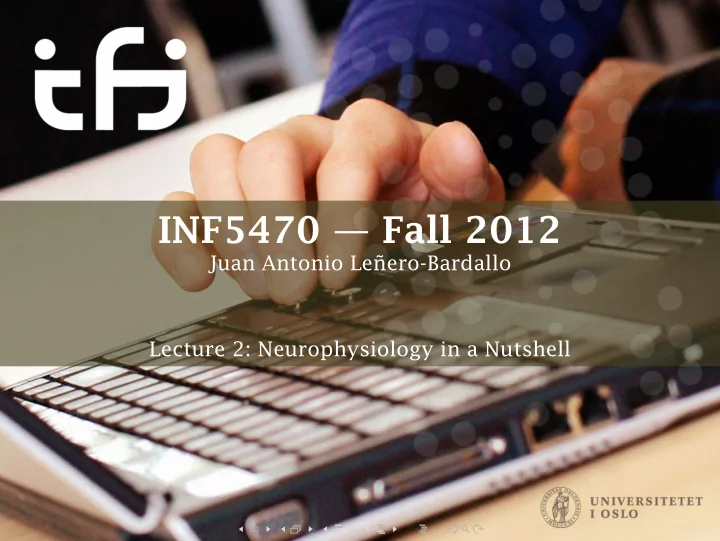

INF5470 — Fall 2012 Juan Antonio Leñero-Bardallo Lecture 2: Neurophysiology in a Nutshell
Content Overview Methods Known Properties Weekly Task Lecture 2: Neurophysiology in a Nutshell 2
Content Overview Methods Known Properties Weekly Task Lecture 2: Neurophysiology in a Nutshell 3
Overview method test subjects observation area temp. res. spat. res. Psycho-physics alert humans cm 2 EEG alert humans patches of brain surface ms 5mm 3 fMRI and PET alert humans brain cross-sections 40ms 0.1 3 mm 3 Extra Cellular Electrode alert test animals neighbourhood of neurons µ s 10 3 µ m 3 Intra Cellular Electr. anesthetized test animals, one neuron µ s slice preparations Fluorescent Tracers anesthetized test animals, a dendritic tree ? < µ m slice preparations Lecture 2: Neurophysiology in a Nutshell 4
Content Overview Methods Known Properties Weekly Task Lecture 2: Neurophysiology in a Nutshell 5
Psychophysics (1/3) Measuring human performance in special tasks in order to make conclusions on physiology. Examples: ◮ reaction times in deciding whether there is food in a picture. ◮ optical illusions ◮ attention tasks: http://viscog.beckman.uiuc.edu/flashmovie/15.php Lecture 2: Neurophysiology in a Nutshell 6
Psychophysics (2/3) (Do you spot an animal?) Lecture 2: Neurophysiology in a Nutshell 7
Psychophysics (3/3) Lecture 2: Neurophysiology in a Nutshell 8
EEG (1/2) Electro-encephalogram: Surface electrodes on skin, measuring correlated activity of a population of neurons. Lecture 2: Neurophysiology in a Nutshell 9
EEG (2/2) Lecture 2: Neurophysiology in a Nutshell 10
fMRI and PET (1/2) fMRI (functional magnet resonance imaging)and PET (positron emission tomography) measure indicators of neuron activity like increased bloodflow and oxygene consumption. PET works with radioactive tracers. FMRI measures blood or suggar levels. Lecture 2: Neurophysiology in a Nutshell 11
fMRI and PET (2/2) Lecture 2: Neurophysiology in a Nutshell 12
Extra Cellular Electrodes/Field Potentials Electrodes in the brain tissue that record field potentials caused by the surrounding neurons. Reconstruction methods are sometimes able to isolate activity of individual neurons. Lecture 2: Neurophysiology in a Nutshell 13
Intra Cellular Electrodes Sharp electrodes and patch clamp electrodes observe activity inside a neuron. Patch clamp amplifier electrodes. Lecture 2: Neurophysiology in a Nutshell 14
Imaging with Fluorecent Tracers For example two photon microscopy to observe dynamics of chemicals, e.g. calcium Lecture 2: Neurophysiology in a Nutshell 15
Left out here: Methods in Neuroanatomy Lecture 2: Neurophysiology in a Nutshell 16
Content Overview Methods Known Properties Weekly Task Lecture 2: Neurophysiology in a Nutshell 17
Brain Parts Lecture 2: Neurophysiology in a Nutshell 18
Cortical Regions (1/3) Lecture 2: Neurophysiology in a Nutshell 19
Cortical Regions (2/3) Lecture 2: Neurophysiology in a Nutshell 20
Cortical Regions (3/3) Lecture 2: Neurophysiology in a Nutshell 21
Orgaization within cortical regions (1/3) Ocular dominance patterns Lecture 2: Neurophysiology in a Nutshell 22
Orgaization within cortical regions (2/3) Ocular dominance patterns Lecture 2: Neurophysiology in a Nutshell 23
Orgaization within cortical regions (3/3) Orientation selection patterns Lecture 2: Neurophysiology in a Nutshell 24
Cortical Layers and Microcolumns(1/3) Lecture 2: Neurophysiology in a Nutshell 25
Cortical Layers and Microcolumns(2/3) Lecture 2: Neurophysiology in a Nutshell 26
Cortical Layers and Microcolumns(3/3) Lecture 2: Neurophysiology in a Nutshell 27
Neurons and Synapses More about those in dedicated lectures Lecture 2: Neurophysiology in a Nutshell 28
Weekly Task 1. Occular dominance patterns form a kind of a Zebra pattern on V1 with two exceptions: a region close to the center and a region at the outskirts is uniformly dominated by input from just one eye. Do you have an explanation? 2. According to the hierarchy of cortical regions in cat cortex assembled by van Essen etal. it catches the eye that quantitatively there are more recurrent connections than feed forward connections in the cortex. Can you speculate on the significane of this fact? Why could that be? Lecture 2: Neurophysiology in a Nutshell 29
Recommend
More recommend